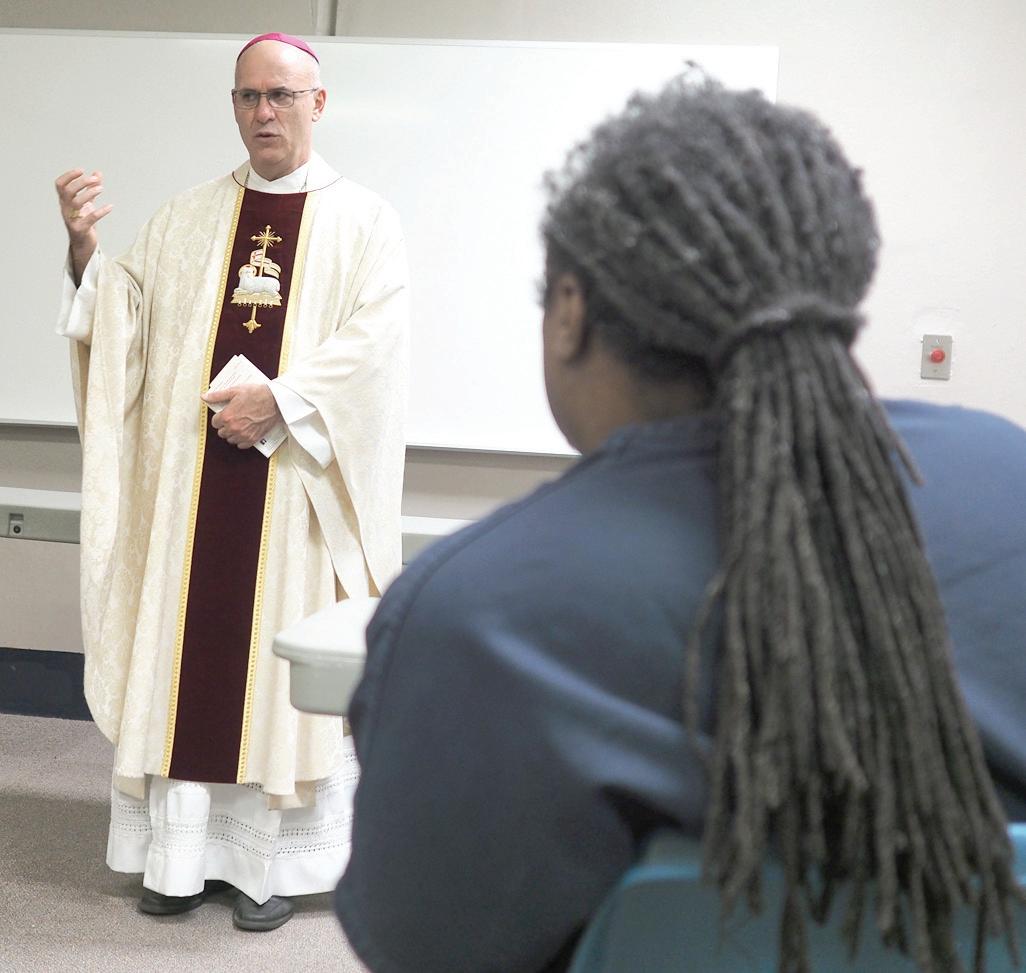
3 minute read
Jail ministry reaches the incarcerated
Jail ministry means many things to many people: The incarcerated, those who work to keep them safe and those who seek to counsel and comfort.
Allison Sturm serves as the contact for Catholic Jail Ministry in the Diocese of Fort Wayne-South Bend.

“There are 14 counties in the diocese. Each one has its own county jail and is run inde- pendently. Policies regarding sacramental and pastoral visits by priest, religious and lay individuals vary,” she said.



It is Sturm’s responsibility to connect with each jail commander and chaplain to get a clear picture of what a Catholic presence can look like.
“Before working in jail ministry, I didn’t understand how different it is from prison ministry. When Bishop Kevin Rhoades visited Allen County Jail years ago wanting to cel-
Leave Your Legacy with the residents of Saint Anne Communities!
The ONLY senior living community in Fort Wayne that offers daily Mass and Sacraments while providing the highest quality of health care.

Invest in honoring the lives of our seniors.
If you would like to give a monetary donation in honor of a loved one or if your business would like to donate, please contact our Fund Development Department at (260) 399-3232 or email miranda.haupert@sacfw.org for our list of needs.
Saint Anne Communities 1900 Randallia Drive Fort Wayne, IN 46805 260-484-5555 • www.sacfw.org ebrate a Mass, he was informed he would have to offer 16 masses in one week just to reach all Catholic men incarcerated.

“This is because the inmates are separated in specific blocks and cannot interact because of upcoming trials. Men and women incarcerated in prisons have already had their sentences adjudicated so there is a greater freedom for educational programs and faith opportunities,” Sturm explained.
Rhoades envisioned this ministry as a way to offer access to Holy Communion and to confession. Unfortunately, the setup at many jails does not make this possible. Some jails only allow video visits where the inmate and visitor sit on opposite sides of a glass partition.
One of the biggest roadblocks is the safety of the inmates and staff. Many jails are understaffed and if there is only one officer present in a certain block, he or she cannot leave that area to escort an inmate down to meet with a priest.
Sturm appreciates the challenges the jail officials face. She has found that many of the jail commanders understand and support the Bishop’s desire to have a Catholic presence.
Her role is to serve as a liaison between jail leadership and the 14 pastors designated by Rhoades. She assists the pastors and their parish communities to consider the opportunities at their respective county jails, which might include Mass, sacramental visits, Bible studies, book cart, pen pals or collecting items like reader glasses.
“Before COVID, there were five active Catholic jail ministries among the 14 counties and each was unique because it conformed to the policies of those given jails,” she said.
The response of these Catholic jail ministries showed respect for their local jail officials and demonstrated what is possible.
Serving in this role also allows Sturm the opportunity to connect with the family members of individuals incarcerated. Recently, in arranging permission for a pastoral visit at the wishes of an inmate’s parents, she was surprised to receive a text from his parents stating he hadn’t received his visit. Upon further checking, Sturm said they learned there were two inmates in that jail with identical names.
“So, we were able to minister to two men,” she said.
Sturm desires to listen, accompany and connect, and she does so with great empathy and care.
For more information, visit diocesefwsb.org/jail-ministry.
Disabled

Continued from page 6
To ease the frustration experienced by the speaker, work on what you do understand and help him or her get the message across. For example, if you make out the word “need,” ask what it is they need. It simplifies the conversation.
Do the same with those who are aging and losing their hearing.
You don’t have to yell at them. But stand where they can see you and don’t hide your mouth when you’re speaking to them. Many read lips, facial expressions and body language to help them get your message. If they have a problem understanding, change your sentence.
As hearing diminishes, so does sound recognition, especially of short one-syllable words like “bus” and “car.”


Before speaking to a person who is deaf or hard of hearing, make sure you get their attention. You can do this by waving your hand or arm or tapping them on the shoulder.
The key in all these encounters is to be polite. Simple courtesy will keep everyone comfortable.
Dining/Leisure/Entertainment


Hoosier Valley Railroad Museum —











